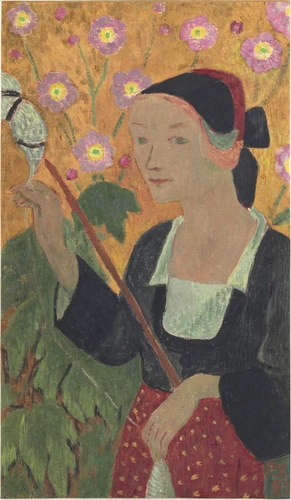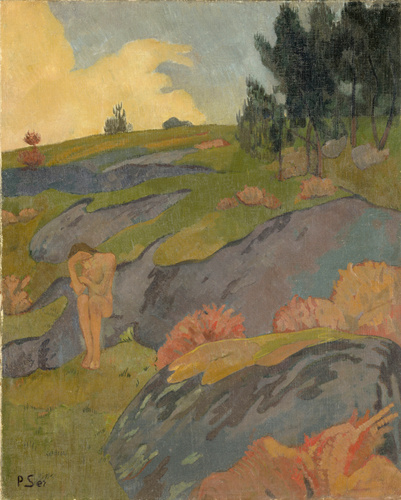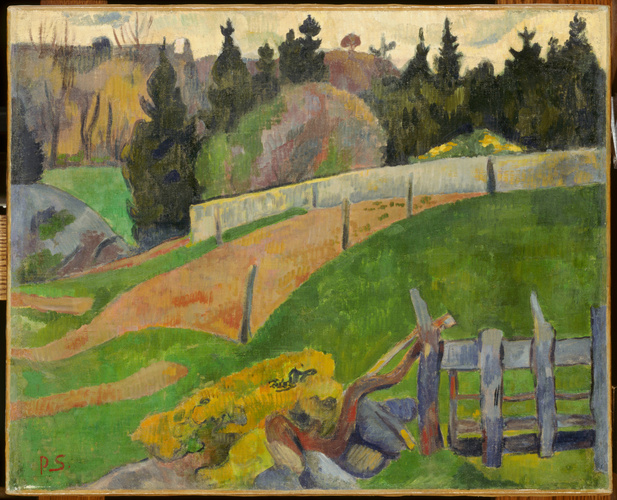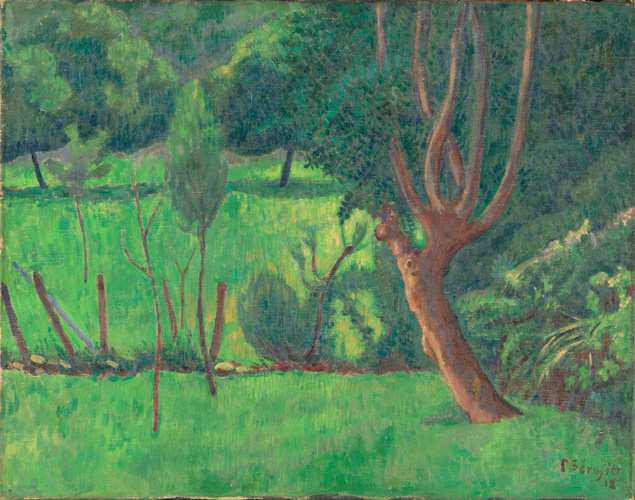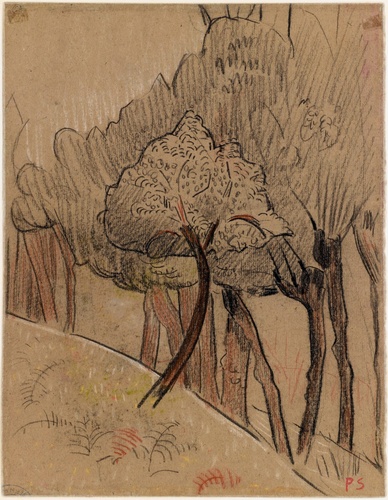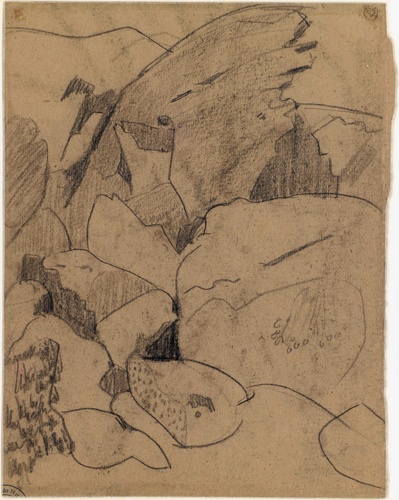Le Talisman, Paysage au Bois d'Amour
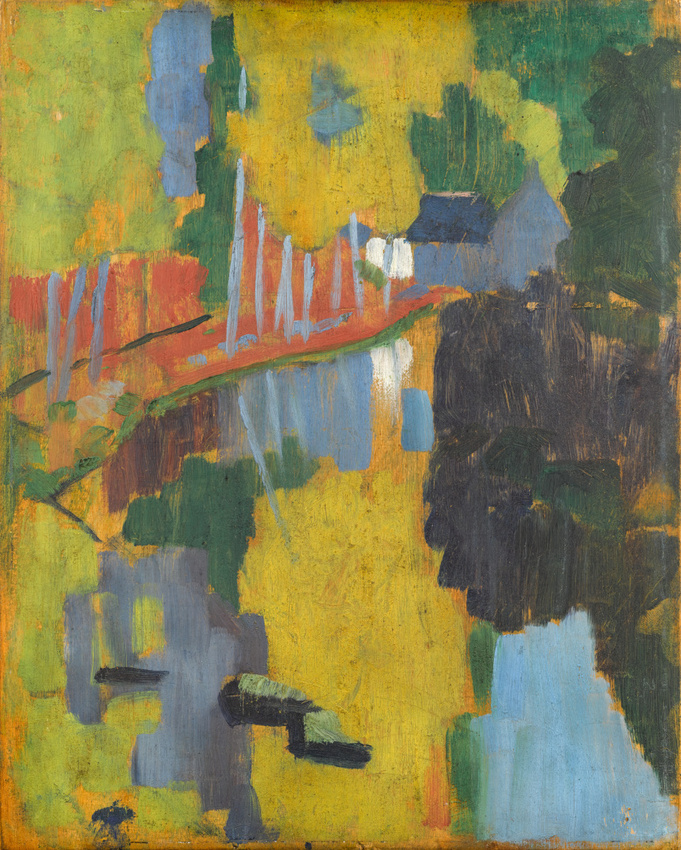
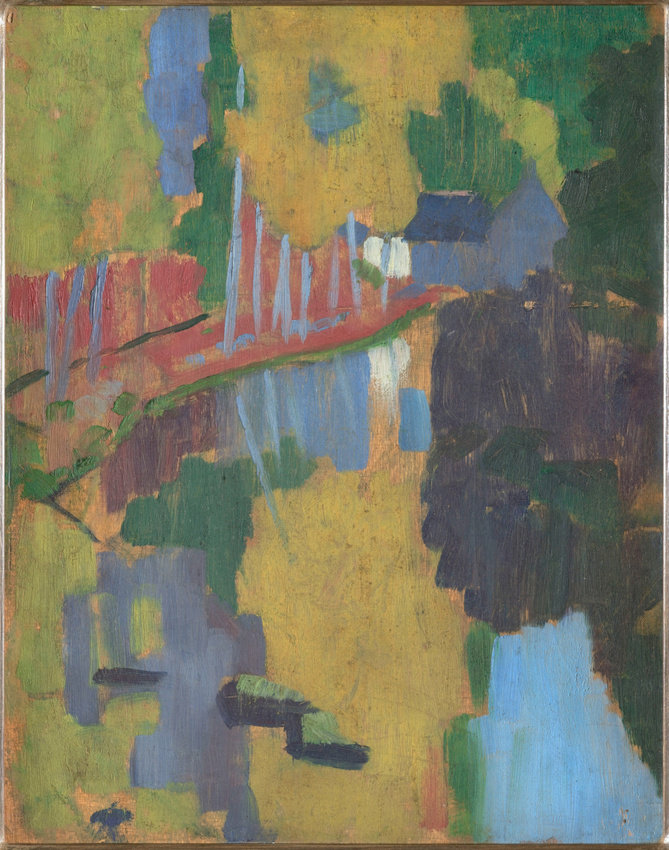
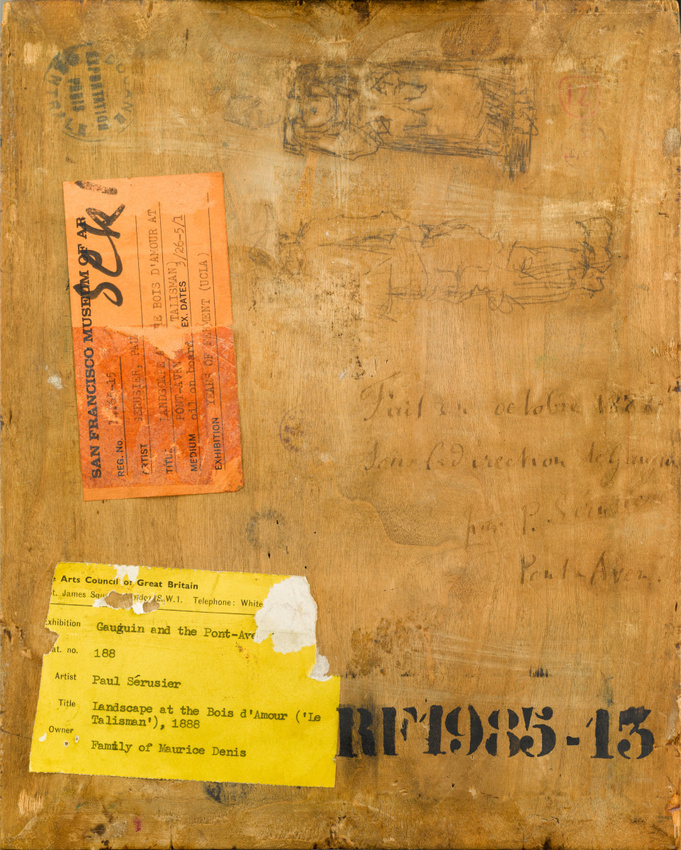

Paul Sérusier sojourned in Pont-Aven during the summer of 1888, as Paul Gauguin, whose advice he followed. On his returning to Paris, he showed his young fellow painters, the future "Nabis" ("prophets" in Hebrew), what was to become their "Talisman".
A close observation of the painting allows one to recognise certain elements of the landscape represented : the wood, at the top on the left, the transversal path, the row of beech trees on the river bank, and the mill, at the back, on the right. Each of these elements is a stain of colour. According to Maurice Denis, Gauguin had told Séruzier : "How do you see these trees? They are yellow. So, put in yellow; this shadow, rather blue, paint it with pure ultramarine; these red leaves? Put in vermilion".
Although they were determined that visual sensation should prevail over the intellectual perception of the world, the impressionists had not given up a conception of painting implying the representation of what they observed. Here the mimetic conception is thoroughly replaced by the search for a coloured equivalent. Maurice Denis explained that in front of this landscape, he and his friends felt "liberated from all the yokes that the idea of copying brought to [our] painters' instincts". Posterity was to see - in retrospect – in this painting the manifesto of a pure painting, autonomous and abstract, related to Maurice Denis's famous statement: "Remember that a painting, before being a battle horse, a nude woman or any anecdote, is essentially a plane surface covered with colours assembled in a certain order.", that was not published before... 1914, in Theories...
- collection Maurice Denis, donné par l'artiste
- collection Boulet-Denis, Clermont (Oise)
- collection M. et Mme Jean-François Denis, Alençon
- 1985, acquis par les Musées nationaux avec la généreuse participation de Philippe Meyer par l'intermédiaire de la Lutèce Foundation (comité du 23/05/1985, conseil du 29/05/1985, arrêté du 03/06/1985)
- 1985, attribué au musée d'Orsay, Paris
- L'école de Pont-Aven et les Nabis, 1888-1908 - galerie Parvillée - France, Paris, 1943, A, n°90
- Exposition de peinture contemporaine. Maurice Denis. Ses maîtres. Ses amis. Ses élèves. - musées nationaux - France, Paris, 1945-1946
- Gauguin et ses amis - galerie Kléber - France, Paris, 1949, N°103
- Eugène Carrière et le Symbolisme - musée de l'Orangerie - France, Paris, 1949-1950
- Die Maler Der Revue Blanche, Toulouse-Lautrec und die Nabis, Bonnard, Vuillard, Vallotton, Denis, Roussel, Roussel, Ranson, Sérusier, Maillol - Kunsthalle Bern - Suisse, Berne, 1951
- Commémoration du Cinquantenaire de la mort de Paul Gauguin (1848-1903) - hôtel de ville - France, Pont-Aven, 1953, n°32
- Paris in the Nineties - Wildenstein Gallery - Royaume-Uni, Londres, 1954
- Paris 1900 - musée Jenisch - Suisse, Vevey, 1954
- Bonnard, Vuillard et les Nabis 1888-1903 - musée national d'art moderne - France, Paris, 1955
- Les sources du XXème siècle - les arts en Europe de 1884 à 1914 - musée national d'art moderne - 1960-1961
- Die Nabis und ihre Freunde : les Nabis et leurs amis - Kunsthalle - Allemagne, Mannheim, 1963-1964, n°243
- Years of Ferment. The Birth of Twentieth Century Art, 1886-1914 - San Francisco Museum of Art - Etats-Unis, San Francisco, 1965, n°16
- Years of Ferment. The Birth of Twentieth Century Art, 1886-1914 - Cleveland Museum of Art - Etats-Unis, Cleveland, 1965, n°16
- Gauguin and the Pont-Aven Group - Tate Gallery - Royaume-Uni, Londres, 1966
- Pont-Aven. Gauguin und sein Kreis in der Bretagne - Kunsthaus Zürich - Suisse, Zurich, 1966, n°253
- Pont-Aven und Nabis - Galleria del Levante - Allemagne, Munich, 1966-1967, n°43
- Maurice Denis et les Nabis - musée des Beaux-Arts - France, Angers, 1967, n°56
- Maurice Denis - musée de l'Orangerie - France, Paris, 1970
- Le Symbolisme en Europe - Museum Boijmans Van Beuningen - Pays-Bas, Rotterdam, 1975-1976
- Le Symbolisme en Europe - musées royaux des Beaux-Arts - Belgique, Bruxelles, 1976
- Le Symbolisme en Europe - Staatliche Kunsthalle - Allemagne, Baden-Baden, 1976
- Le Symbolisme en Europe - Galeries nationales du Grand Palais - France, Paris, 1976
- Vom Licht zur Farbe [De la lumière à la couleur] Nachimpressionistisch Malerei zwischen 1896 und 1912 - Städtische Kunsthalle - Allemagne, Düsseldorf, 1977, n°103
- Post-Impressionism. Cross-Currents in European Painting - Royal Academy of Arts - Royaume-Uni, Londres, 1979-1980, n°187 à Londres, n°115 à Washington
- Post-Impressionism - Cross-Currents in European and American Painting 1880-1906 - National Gallery of Art - Etats-Unis, Washington, 1980, n°187 à Londres, n°115 à Washington
- Vincent Van Gogh and the birth of Cloisonism - Art Gallery of Ontario - Canada, Toronto, 1981, Toronto n°28, Amsterdam n°137
- Vincent Van Gogh and the birth of Cloisonism - Rijksmuseum - Pays-Bas, Amsterdam, 1981, Toronto n°28, Amsterdam n°137
- L'éclatement de l'Impressionisme - musée départemental Maurice Denis - France, Saint-Germain-en-Laye, 1982-1983
- Debussy e il Simbolismo - Académie de France - Italie, Rome, 1984
- Le chemin de Gauguin : genèse et rayonnement - musée départemental Maurice Denis - France, Saint-Germain-en-Laye, 1985-1986
- Anciens et Nouveaux : choix d'oeuvres acquises par l'Etat ou avec sa participation de 1981 à 1985 - Galeries nationales du Grand Palais - France, Paris, 1985-1986
- 1886-1986, cent ans, Gauguin à Pont-Aven - musée de Pont-Aven - France, Pont-Aven, 1986, N°67
- Le Prieuré célèbre le Talisman - musée départemental Maurice Denis - France, Saint-Germain-en-Laye, 1988, n°9
- De Manet à Matisse, 7 ans d'enrichissement au musée d'Orsay - musée d'Orsay - France, Paris, 1990-1991
- Nabis. Bonnard, Vuillard, Maurice Denis, Vallotton... (1888-1900) - Kunsthaus Zürich - Suisse, Zurich, 1993
- Nabis. Bonnard, Vuillard, Maurice Denis, Vallotton... (1888-1900) - Galeries nationales du Grand Palais - France, Paris, 1993-1994
- Art Nouveau 1890-1914 - Victoria and Albert Museum - Royaume-Uni, Londres, 2000, n°4.1
- Art Nouveau 1890-1914 - National Gallery of Art - Etats-Unis, Washington, 2000-2001, n°4.1
- Gauguin y los origines del simbolismo - Museo Thyssen-Bornemisza - Espagne, Madrid, 2004-2005, n°84
- Gauguin's vision - The National Gallery of Scotland - Royaume-Uni, Edimbourg, 2005
- Temps d'harmonie : paradis d'artistes au XIXe siècle - City museum - Japon, Kobe, 2006
- Temps d'harmonie : paradis d'artistes au XIXe siècle - Metropolitan Art Museum - Japon, Tokyo, 2007
- Van Gogh, Gauguin, Cézanne & beyond, Post-Impressionism from the Musée d'Orsay - National Gallery of Australia - Australie, Canberra, 2009-2010, cat.72, p.214, 50, 65, 152, 186, 188, 214, 218, 266 et détail p.212-213
- Post-impressionnisme - 115 chefs-d'oeuvre de la collection du musée d'Orsay - National Art Center - Japon, Tokyo, 2010, cat n°64, reprod., p.133, détail p.140
- Van Gogh, Gauguin, Cézanne & beyond, Post-Impressionism from the Musée d'Orsay - M. H. De Young Memorial Museum - Etats-Unis, San Francisco, 2010-2011, cat.72, p.214, 50, 65, 152, 186, 188, 214, 218, 266 et détail p.212-213
- Debussy, la musique et les arts - musée de l'Orangerie - France, Paris, 2012
- Debussy, la musique et les arts - Bridgestone Museum of Art - Ishibashi Foundation - Japon, Tokyo, 2012
- Impresionistas y postimpresionistas : el nacimiento del arte moderno : obras maestras del musée d'Orsay - Fundación Mapfre - Espagne, Madrid, 2013
- El triunfo del color. De Van Gogh a Matisse : colecciones de los museos d'Orsay y de l'Orangerie - Fundación Mapfre - Espagne, Barcelone, 2015-2016
- O triunfo da Cor. O pós-impressionismo: obras-primas do Musée d'Orsay e do Musée de l'Orangerie - Centro cultural Banco do Brasil - Brésil, Rio de Janeiro, 2016
- Le murmure et le fracas, chefs-d’œuvre Nabis du musée d’Orsay - Mitsubishi Ichigokan Museum - Japon, Tokyo, 2017
- Le "Talisman" de Sérusier, une prophétie de la couleur - musée de Pont-Aven - France, Pont-Aven, 2018-2019
- Le "Talisman" de Sérusier, une prophétie de la couleur - musée d'Orsay - France, Paris, 2019
-
Chassé, Charles, Gauguin et le groupe de Pont-Aven, 1921, p.80
-
Denis, Maurice, Paul Sérusier. ABC de la peinture, Paris, Floury, 1942, p.42
-
Bazin, Germain, L'époque impressionniste, Paris, Pierre Tisné, 1947
-
Humbert, Agnès, Les Nabis et leur époque, 1888-1900, Genève, P. Cailler, 1954
-
Chassé, Charles, Les Nabis et leur temps, Lausanne, Bibliothèque des Arts, 1960
-
Rewald, John, Le Post-impressionnisme de Van Gogh à Gauguin, Paris, Éditions Albin Michel, 1961
-
Denis, Maurice, Du symbolisme au classicisme. Théories, Paris, Hermann, 1964
-
Jaworska, Wladyslawa, Paul Gauguin et l'école de Pont-Aven, Neuchâtel, Ides et Calendes, 1971
-
Guicheteau, Marcel, Paul Sérusier, Paris, SIDE, 1976, n°2
-
Mauner, George L., The Nabis : Their History and Their Art, 1888-1896, New York, Garland, 1978
-
Boyle-Turner, Caroline, Paul Sérusier, Ann Arbor, Umi Research Press, 1983
-
Thomson, Belinda, The Post-Impressionnists, Oxford, Phaidon Oxford, 1983
-
Cogeval, Guy, Les Années post-impressionnistes, Paris, Nouvelles éditions françaises, 1986
-
Kelder, Diane, L'Héritage de l'Impressionnisme - les sources du XXe siècle, New York, [s.n.], 1986
-
Rosenblum, Robert, Les Peintures du Musée d'Orsay, Paris, Nathan, 1989
-
Cachin, Françoise, L'Art du XIXe siècle 1850-1905, Paris, Citadelles, 1990
-
(dir.) Cogeval, Guy, Le Musée d'Orsay à 360 degrés, Paris, Skira ; Flammarion ; Musée d'Orsay, 2013, p. 184
-
Aumasson, Pascal ; Pigallet, Mathilde ; Le Dauphin, Gildas, Les Peintres de Pont-Aven et les Nabis dans les collections du musée de Brest, Edition Locus Solus, 2013, p.28
-
Burns, Thea ; Saunier, Philippe, L'Art du pastel, Paris, Citadelles & Mazenod, 2014, p. 321
-
Salles Georges [préface] ; Dorival, Bernard [introd.], Maurice Denis, ses maîtres, ses amis, ses élèves, cat.exp. (Exposition itinérante, novembre 1945 à août 1946), Paris, Direction des musées ; Musée national d'art moderne, 1945, n° 59
-
Dorival, Bernard (dir.) ; Humbert, Agnès, Cassou, Jean (préf.), Bonnard, Vuillard et les Nabis (1888-1903), cat. exp. (Paris, musée national d'art moderne, du 8 juin au 2 octobre 1955), Paris, Éditions des musées nationaux, 1955, n° 144
-
Cassou, Jean (dir.) ; Châtelet, Albert (dir.) ; Pevsner, Nicolas ; Langui, E, Les sources du XXe siècle : les arts en Europe de 1884 à 1914, cat. exp. (Paris, musée national d'art moderne, du 04/11/1960 au 23/01/1961), Paris, musée national d'art moderne, 1960, n° 651
-
Sutton, Denys (préf.), Gauguin and the Pont-Aven group, cat. exp. (Londres, Tate Gallery, du 7 janvier au 13 février 1966), Londres, Tate Gallery, 1966, n° 188
-
Ebbinge-Wubben, Johan Conrad ; Hammacher-Van Den Brande, Renilde, Le Symbolisme en Europe, cat. exp. (Exposition itinérante 1975-1976), Paris, Réunion des musées nationaux, 1976, n° 219
-
Warnod, Jeanine ; Anquetil, Marie-Amélie, L'Éclatement de l'Impressionnisme, cat. exp. (Saint-Germain-en-Laye, Musée départemental du Prieuré, 1982-1983), [s.n.], 1982, n° 49
-
Cogeval, Guy ; Lesur, François, Debussy e il simbolismo, cat. exp. (Rome, Académie de France, de avril à juin 1984), Rome, Fratelli Palombi, 1984, n° 62
-
Anciens et nouveaux : Choix d'oeuvres acquises par l'Etat ou avec sa participation de 1981 à 1985, cat. exp. (Paris, Galeries nationales du Grand Palais, du 05/11/1985 au 03/02/1986), Paris, Réunion des Musées Nationaux, 1985, n° 138
-
Cachin, Françoise [sous la direction de] ; Bascou, Marc, De Manet à Matisse : sept ans d'enrichissement au Musée d'Orsay, cat.exp. (Paris, musée d'Orsay, 12 novembre 1990-10 mars 1991), Paris, Réunion des musées nationaux, 1990, p. 123
-
Watkins, Nicolas, Beyond the Easel. Decorative Painting by Bonnard, Vuillard, Denis and Roussel, 1890-1930, cat. exp. (Chicago, Art institute of Chicago, 25 février-16 mai 2001 ; New York, Metropolitan museum of art, 26 juin-9 sept. 2001), The Genesis of a Decorative Aesthetic, Chicago, The Art Institute, 2001
-
Bouillon, Jean-Paul, Maurice Denis (1870-1943), cat. exp. (Paris, musée d'Orsay, 31 octobre 2006 - 21 janvier 2007 ; Montréal, musée des Beaux-Arts de Montréal, 22 février - 20 mai 2007 ; Rovereto, Museo di arte moderna et contemporanea, 23 juin - 23 septembre 2007), Le théoricien, Paris, Réunion des musées nationaux, 2006, p.35
-
Delouche, Denise, Maurice Denis et la Bretagne, cat.exp. (Pont-Aven, musée de Pont-Aven, Ploëzal, Domaine départemental de La Roche-Jagu, 6 juin-5 octobre 2009), Quimper, Palatines, 2009, repr. 16
-
Cogeval, Guy (dir.), Mathieu, Caroline (dir.), Jiménez, Burillo (dir), Cahn, Isabelle, Impressionismo. Paris e a modernidade : obras-primas, Musée d'Orsay, cat. exp. (Sao Paulo, 4 août-7 octobre 2012 ; Rio de Janeiro, 22 octobre 2012-13 janvier 2013 ; Madrid, 12 février-5 mai 2013), São Paulo / Madrid, Expomus / Fundación Mapfre, 2012, n°55
-
Cogeval, Guy ; Nectoux, Jean-Michel ; Rey, Xavier, Debussy, la musique et les arts. Entre impressionnisme et symbolisme, cat. exp. (Paris, musée de l'Orangerie, du 22/02/2012 au 11/06/2012 ; Tokyo, Bridgestone Museum of Art - Ishibashi Foundation, du 13/07/2012 au 14/10/2012), Tokyo, Nikkei, 2012, n° 155
-
Rapetti, Rodolphe ; Thomson, Richard ; Fowle, Frances, Dreams of Nature : Symbolism from van Gogh to Kandinsky, cat. exp. (Amsterdam, Van Gogh Museum, du 24/02/2012 au 17/06/2012 ; Edinburgh, Scottish National Gallery, du 14/07/2012 au 14/10/2012 ; Helsinki, Ateneum Art Museum, Finnish National Gallery, du 16/11/2012 au 17/02/2013), Bruxelles, Mercatorfonds, 2012, fig. 13, p. 31 ; p. 33 ; p. 34 (reprod. coul.) ; p. 35 ; p. 179
-
Cahn, Isabelle ; Cahn, Isabelle, El triunfo del color. De Van Gogh à Matisse : colecciones de los museos d'Orsay y de l'Orangerie, cat. exp. (Barcelone, Sala Fundacion Mafpre, Casa Garriga i Nogues, 10 octobre 2015-10 janvier 2016), Madrid Paris, Fundacion Mafpre, 2015, n° 31, p. 106-107
-
Schlesser, Thomas, Sensations de nature. De Courbet à Hartung, cat. exp. (Ornans, musée Courbet, 4 juillet - 12 octobre 2015), La peinture, fusion avec le vivant, Paris, Lienart, 2015, p.49-55
-
Cogeval, Guy ; Cahn, Isabelle; Takahashi, Akiya, Le murmure et le fracas. Chefs d'oeuvre Nabis des collections du musée d'Orsay, cat. exp. (Tokyo, Mitsubishi Ichigokan Museum, du 04 février au 21 mai 2017), Tokyo, The Yomiuri Shimbun, 2017, n° 7
-
Bernardi, Claire ; Guille des Buttes-Fresneau, Estelle ;, Le Talisman de Paul Sérusier. Une prophétie de la couleur, cat. exp. (Pont-Aven, musée de Pont-Aven, du 30/06/2018 au 06/01/2019 ; Paris, musée d'Orsay, du 29/01/2019 au 02/06/2019), Paris, musée d'Orsay, RMN-GP, 2018, n° 1, p. 5-6 ; p. 173
-
Grillet, Thierry ; Tessier, Florence ; Gökalp, Sébastien ; Baraton, Alain, "Vous êtes un arbre !" De la fascination à la représentation, cat. exp. (Deauville, Les Franciscaines, du 12 mars au 5 juin 2022), Rouen, Editions des Falaises, 2022, ill. reprod. coul., p. 68
-
Toft-Eriksen, Lars ; Meilvang, Emil Leth, The savage eye, cat. exp. (Oslo, Munch Museet, du 12 février au 08 mai 2022), Oslo, Munch Museet, 2022, p. 91 (reprod. coul.)
-
Compin, Isabelle ; Roquebert, Anne, Catalogue sommaire illustré des peintures du Musée du Louvre et du Musée d'Orsay, Paris, Réunion des musées nationaux, 1986
-
Hoog, Michel, Gauguin, vie et oeuvre, Paris, Nathan, 1987
-
Compin, Isabelle [coordination] ; Lacambre, Geneviève [coordination] ; Roquebert, Anne, Musée d'Orsay. Catalogue sommaire illustré des peintures, Paris, Réunion des musées nationaux, 1990, vol.2, p.422-423
Do you have a question where you have additional knowledge about this work? You can write to us to suggest improvements to the file.
Make a suggestion